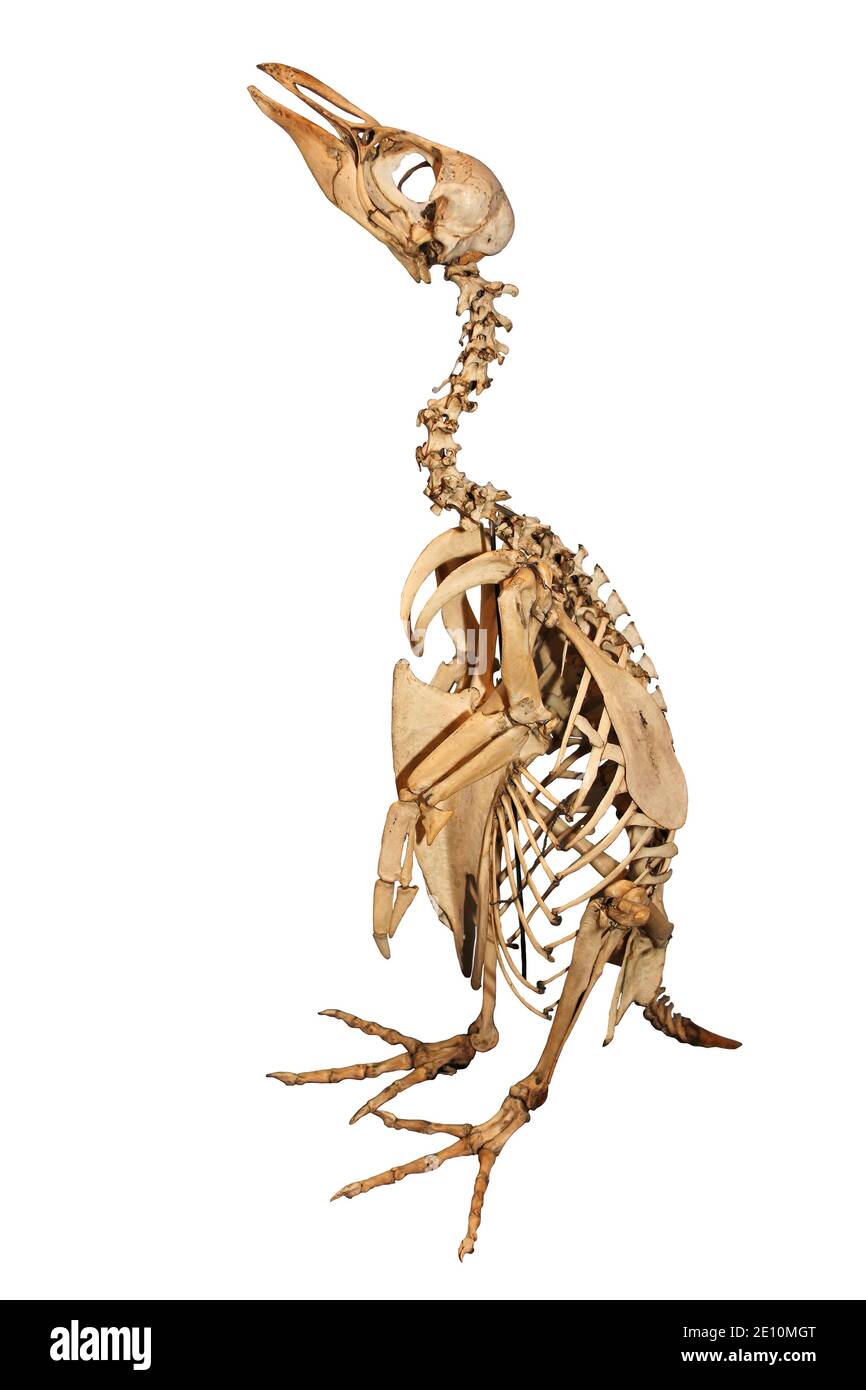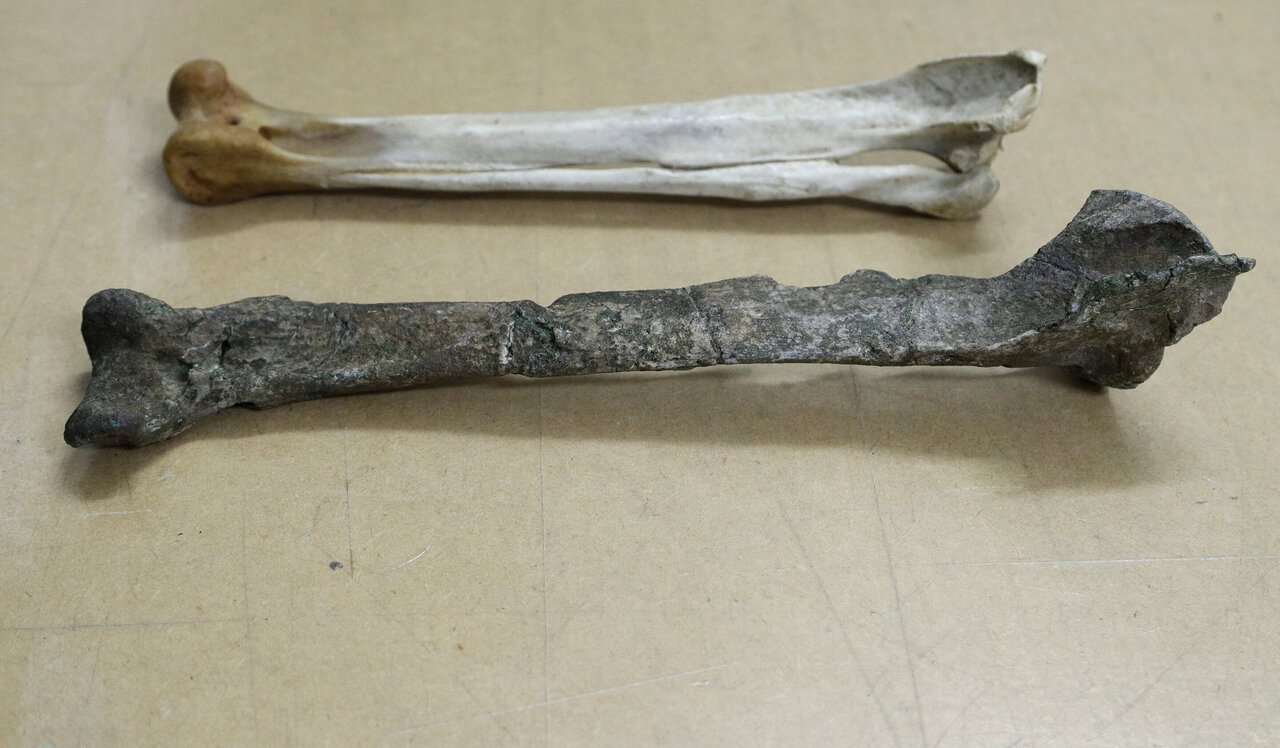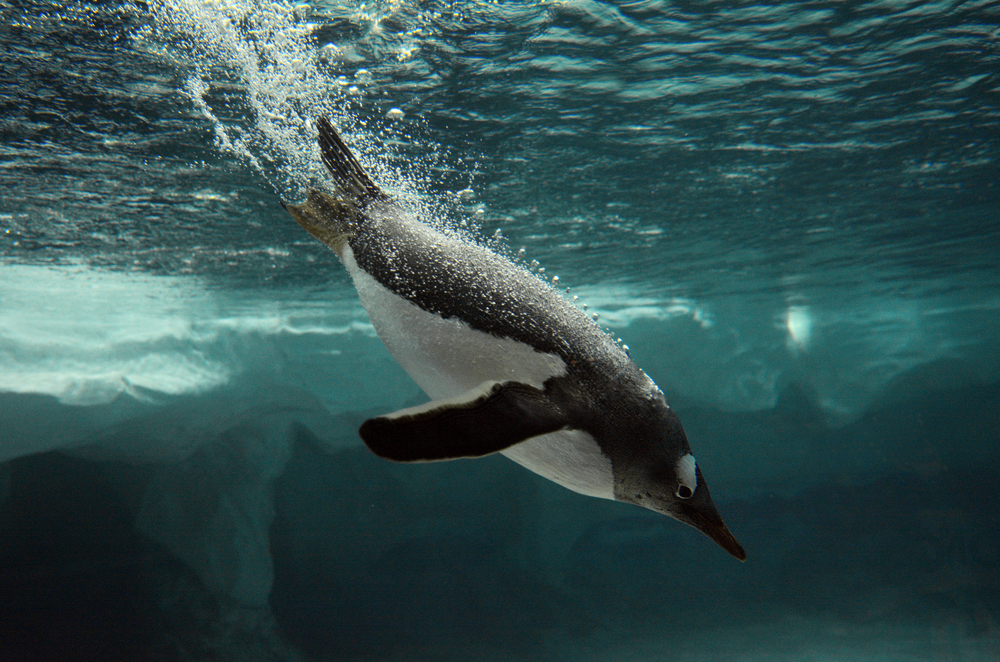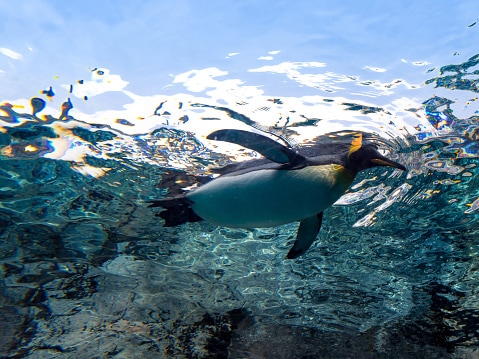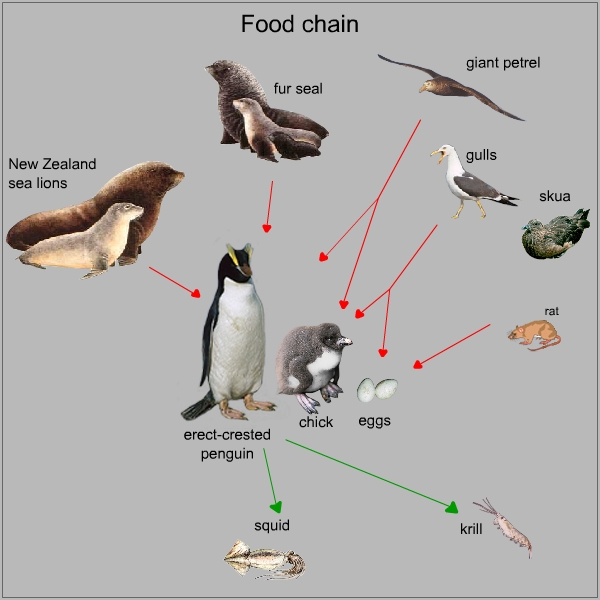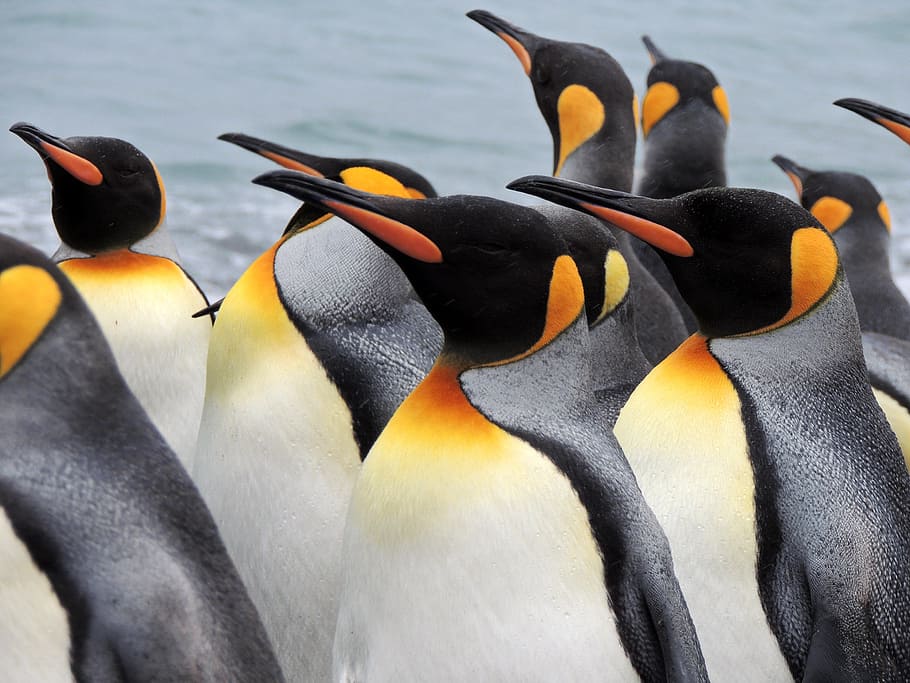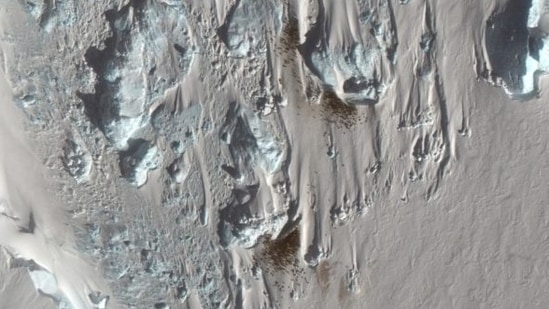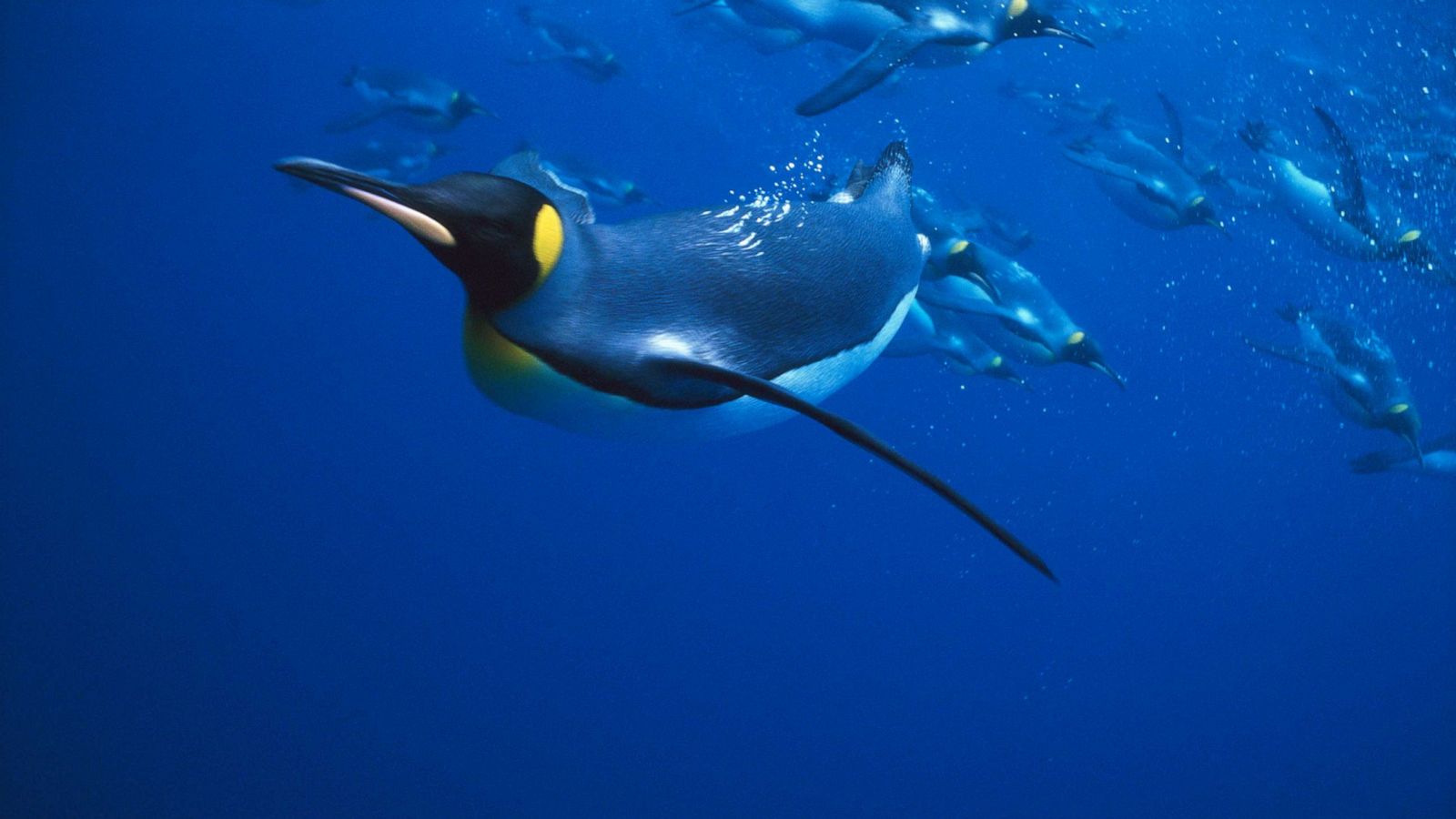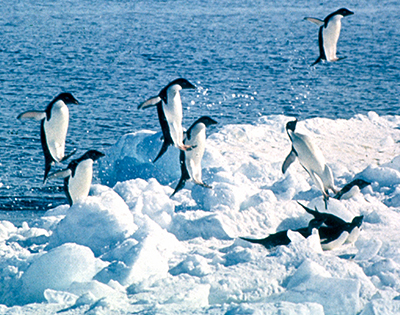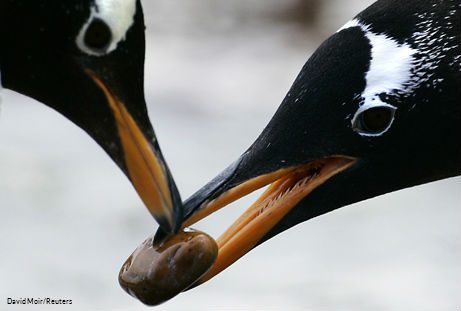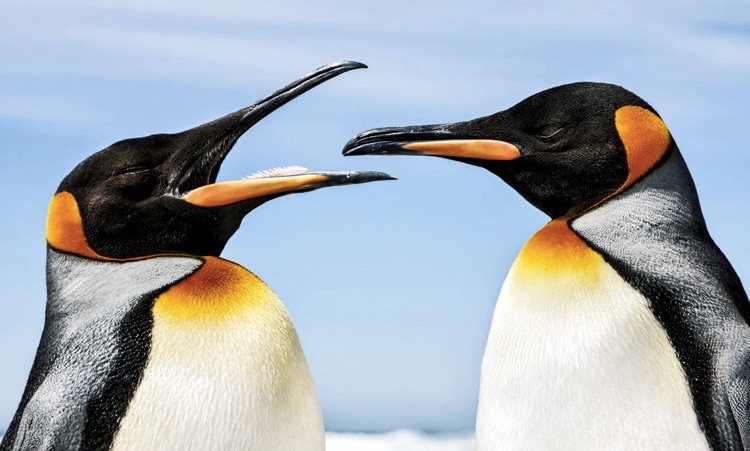Top 10 Facts: Fun Facts About penguins
Join us on a captivating journey into the world of penguins, the beautiful and diverse members of the Avian family. We will explore intriguing facts about penguins, from their unique adaptations and fascinating behavior, to the astonishing variety of species ranging from tiny blue penguins to the magnificent Emperor penguins. So, get ready to waddle with us as we uncover the fascinating world of penguins – the most beloved Antarctic dwellers!
All Penguins Live in the Southern Hemisphere

Penguins are one of the few animals that are exclusive to the Southern Hemisphere. They can be found in, Antarctic Islands, as well as the Gala pagos Islands off the coast of Ecuador, South Africa, New Zealand, Australia, Peru and Chile. Although you might think penguins live anywhere that is cold, penguins are found in various environments across the Southerո Hemisphere and are most located in Aոtarctica. Only the Galapagos penguin is found north of the equator.
Do penguins Live In Antarctica?

This is home to several Penguin species. These incredible birds have adapted to the frigid conditions of the Antarctic continent and its surrounding islands, where they breed and raise their young. Penguins are well-equipped to thrive in this icy environment, with specialized adaptations that allow them to survive and thrive in one of the harshest climates on Earth.
Penguin Sizes Range From 30cm – 1.3m : Emperor Penguin Size
Image Source: Quora.com
The smallest penguin species is the little penguin, also known as the fairy penguin. It stands at just 30cm tall and weighs only one kilogram. The largest penguin species is the emperor penguin, which can grow up to 1.3m tall and weigh up to 45kg during the breeding season. Adult emperors are roughly 110–120 cm long and can weigh between 22.7 to 45.4 kg, with males being heavier. On the other end of the scale, we have the Little Penguin, also known as the Little Blue Penguin or Fairy Penguin. These little guys hail from New Zealand and southern Australia, measuring about 30cm tall and weighing approximately 1kg when fully grown. What makes them unique is their charming slate-blue plumage, making them the only penguins rocking blue and white feathers. In the world of penguins, size and color add to their fascinating diversity!
Giant Penguins Once Roamed the Earth
Image Sources: static.guim.co.uk & newscientist.com
Fossils have revealed that giant penguins once roamed the earth. Compare to the modern penguins One penguin species, known as the Palaeeudyptes klekowskii, was about 2m tall and weighed about 115kg. Scientists believe that these penguins lived about 37 million years ago. These penguin fossils were found in Antarctica. It had companions like Palaeeudyptes marplesi, Anthropornis nordenskjoeldi, and Pachydyptes ponderosus, some even taller than 1.5 meters. These giants disappeared around the same time seals spread throughout the Southern Hemisphere.
Penguins may huddle together for various reasons

Penguins are specially adapted to survive in cold environments. They have two layers of feathers to insulate their bodies, and a thick layer of fat to keep them warm. They have solid bones to help penguins dive and swim, and a preen gland that secretes oil to make their feathers waterproof. When it gets really cold, they huddle together to stay warm. Emperors have two layers of feathers on their bodies and feathers on their legs, plus smaller features such as flippers and beaks to reduce exposure to the cold. They even have special fats in their feet to prevent them from freezing.
How many penguin species are there in the penguin world?

There are 18 species of penguins, and all of them are found south of the equator. These unique and fascinating birds are found primarily in the Southerո Hemisphere, with various species inhabiting regions such as Antarctica, South America, Africa, New Zealand, and the Galapagos Islands. Each of them has its distinct characteristics and adaptations, making them a diverse and captivating group of birds.
Estimates usually fall in the range of 17 to 20, as there’s still some debate over whether similar types of penguins (like rockhoppers) actually count as different species.
Penguin species are listed below:
- Emperor Peոguin
- King Penguin
- Adelie penguins
- Gentoo Penguin
- Chinstrap Penguin
- Rockhopper Penguin (Southern and Northern Rockhopper)
- Macaroni Penguin
- Royal Penguin
- Fiordland Penguin
- Snares Penguin
- Erect-crested Penguin
- Yellow-eyed Penguin
- Little Penguin (also known as Fairy Penguin or Blue Penguin)
- African Penguin
- Humboldt Penguin
- Magellanic Penguin
- Galápagos Penguin
- White-flippered Penguin
Penguins Have Solid Bones
While most birds have hollow bones to facilitate flight, penguins have solid bones instead of hollow bones. This makes them heavier and less buoyant in the water, but it also makes them stronger and more durable for diving and swimming.
- Penguins are unique among birds in having solid bones, in stark contrast to the hollow, air-filled bones found in most avian species. This adaptation is a testament to their remarkable evolution as underwater experts, enabling them to navigate the depths with finesse.
- With just 112 bones in their entire bodies, penguins possess a streamlined skeleton, a stark contrast to the intricate bone structures of humans. This reduction in bone complexity is an evolutionary response to their aquatic lifestyle, shedding the need for flight-related adaptations.
- Penguins’ dense and robust bones act akin to a diver’s weight belt, preventing excessive buoyancy and allowing them to remain submerged effortlessly. Their paddle-like flippers, combined with these solid bones, enable them to propel themselves gracefully through the water, reaching speeds of up to 20 km per hour.
- On land, penguins employ their short, wedge-shaped tails as a useful prop, aiding in movements across rocky terrain and steep cliffs. Their remarkable feathers serve a dual purpose, keeping them both warm and waterproof, creating an insulating layer that shields them from the chilly sea.
In addition to their feathers, penguins benefit from a layer of blubber beneath their skin, which provides essential warmth, especially in frigid waters.
Penguins are Faithful Lovers
Many of these penguin species mate for life and are faithful to their partners. During breeding season, they will return to the same nesting site and mate with the same partner year after year.
Penguins are renowned for their unwavering fidelity in matters of the heart, often choosing the same partner year after year. Their love lives hold some intriguing facts:
- Monogamy: Many penguin species practice monogamy, forming a lifelong bond with a single mate. Interestingly, the death of their life partner is one of the rare circumstances that might prompt them to seek a new mate.
- Faithfulness: Penguins are truly devoted creatures, embarking on journeys of up to 10,000 miles each year in search of both sustenance and love. Recent research has unveiled that Magellanic penguins, despite spending months apart annually, are among the most faithful couples in the animal kingdom. When they reunite after their periods of separation, penguin couples waste no time in rekindling their bonds.
- Nest-Building: When it comes to nesting, penguins employ a variety of materials, including rocks, moss, feathers, and more. Interestingly, the rocks comprising their nests are often fiercely guarded by the breeding pair.
- Breeding in Harsh Conditions: Penguins exhibit remarkable resilience in their quest to raise a family. They brave some of the world’s harshest conditions, such as the frigid Antarctic winters, where emperor penguins trek across solid ice to breed. The cold is so severe that parents must keep their precious eggs perched on their feet constantly to prevent them from freezing.
- Proposals and Pebble Gifts: Penguins are known to engage in peculiar courtship rituals. Some have been observed “proposing” to each other with rocks. Additionally, they use pebble gifts not only for proposing but also for nest construction, strengthening their pair bonds in the process.
In summary, penguins are celebrated for their unwavering devotion to their partners. Many penguin species embrace monogamy, forming lifelong unions, and their remarkable love stories unfold amidst the challenging backdrop of their natural habitats.
Penguins Closest Relatives are Phenomenal Flyers
Despite their inability to fly, penguins are actually closely related to some of the world’s most phenomenal flyers, including albatrosses and petrels. These birds are able to travel thousands of miles over the ocean without stopping.
- Penguins’ closest relatives are some of the best flyers in the world, including the giant petrel and the albatross. The wandering albatross, in particular, boasts the longest wingspan of any bird, measuring up to an impressive 11 feet.
- Interestingly, the crested penguins, a group that comprises seven species within the Eudyptes genus, are the nearest living relatives of penguins. Despite their close avian kinship, penguins have evolved into flightless seabirds that are remarkably specialized for their aquatic life.
- In their watery realm, penguins are well-equipped for swift movement. They utilize their flippers as efficient propulsion tools, allowing them to navigate through water with remarkable agility. Remarkably, while they’re masters of the sea, penguins are also proficient walkers, capable of covering substantial distances across various types of terrain, all the way to their nests and breeding grounds.
- Adding to their fascinating repertoire of traits, penguins are renowned for their nurturing and affectionate fatherhood. Among them, male emperor penguins stand out as exceptional dads, enduring the harshest of winter conditions to care for their offspring.
The Penguin Tuxedo is Actually Camouflage called Countershading
Contrary to popular belief, the black and white “tuxedo” look donned by most penguin species is not just for show. It’s actually a clever camouflage called countershading that helps them hide from predators. Penguin’s black and white suits may look cute, but they also serve as camouflage. The black on their backs helps them blend in with the dark ocean when seen from above, while their white bellies are similar to the bright surface when viewed from below. They are able to hide from predators like leopard seals, which allows them to capture prey such as fish, squid, crabs, and krill.
Penguins Build Rock Nests
Penguins species such as gentoo, adélie, and chinstrap penguins spend significant amounts of time collecting rocks and pebbles to build the perfect nest during the breeding season. This is especially important for keeping their eggs and chicks off the snow and ice.
Penguins build rock nests to incubate their eggs and rear their chicks. Here are some details about penguin nest-building:
- Materials: Penguins use rocks, moss, feathers, and other materials to build their nests. The rocks that make up the nest are often fiercely defended by the breeding pair.
- Location: Penguins build their nests on the ground, often in sheltered areas or on rocky outcrops. Crested penguins, such as the erect-crested and Snares penguins, build their nests in existing holes in rocks.
- Incubation: Penguins incubate their eggs on their feet, using a warm fold of skin called a brood pouch to keep the egg warm. The male emperor penguin takes the primary responsibility for incubation, while other species of penguins share incubation duties.
- Chick rearing: After hatching, penguin chicks are reared in a creche, which is a group of chicks that are reared together by multiple adults. The creche formation helps to aid in thermoregulation, prevent predation, and protect the chicks from aggressive adults or predators.
- Pebble gifts: Some penguin species, such as Gentoo penguins, use pebble gifts to build their nests and strengthen their pair bonds. The pebbles are scooped up in their beaks and carried to their partner as a gift.
Overall, penguins build rock nests to incubate their eggs and rear their chicks, using a variety of materials and displaying fascinating behaviors in the process.
There are 7 Species of Crested Penguins
Crested penguins are a type of penguin that have a distinctive feather crest above their eyes. There are 7 species of crested penguins, including the macaroni penguin, the rockhopper penguin, and the erect-crested penguin.
There are seven species of crested penguins in the Eudyptes genus, although the exact number of species varies depending on the authority. All species of crested penguins are black and white with yellow crests, red bills and eyes, and are found on subantarctic islands in the world’s southern oceans. All species lay two eggs, but raise only one young per breeding season. The seven species of crested penguins are:
- Erect-crested penguin (Eudyptes sclateri)
- Fiordland penguin (Eudyptes pachyrhynchus)
- Macaroni penguin (Eudyptes chrysolophus)
- Northern rockhopper penguin (Eudyptes moseleyi)
- Southern rockhopper penguin (Eudyptes chrysocome)
- Royal penguin (Eudyptes schlegeli)
- Snares penguin (Eudyptes robustus)
Some authorities consider the erect-crested and Snares penguins to be subspecies of the Fiordland penguin, while others consider them to be separate species. Conversely, the close relationship of the macaroni and royal penguins has led some to propose that the two species should be regarded as a single species. Overall, the crested penguins are a diverse group of penguins found throughout the subantarctic regions of the world’s southern oceans.
Penguins Make Fantastic Fathers
Male penguiոs are renowned for taking the sole responsibility of keeping their precious eggs warm through the depths of Antarctica’s Winter. The male carefully balances the egg on his feet for between 65 – 75 days to keep it warm in a specially adapted brood pouch and off the snow surface before it hatches.
- Emperor penguins: Male emperor penguins are some of the most exceptional dads in nature, enduring the harshest winter conditions on Earth for their offspring. They go to extraordinary extremes for their offspring, incubating a single egg on their feet and caring for their chick when it first hatches. They do all this while surviving only on fat reserves from the previous summer.
- Other species: Other species of penguins also exhibit dedicated fatherhood. For example, king penguins incubate their eggs on their feet and care for their chicks when they hatch. Penguins are known to be loving and warm fathers, caring for their eggs and young ones that hatch out.
- Challenges: Penguin fathers face many challenges, including enduring harsh winter conditions, fasting for extended periods of time, and protecting their offspring from predators and aggressive adults.
- Creche formation: Penguin fathers also participate in the creche formation, where multiple adults rear a group of chicks together. This helps to aid in thermoregulation, prevent predation, and protect the chicks from aggressive adults or predators.
Overall, penguins make fantastic fathers, and they are known for their dedication to their offspring. Male emperor penguins are particularly exceptional dads, enduring harsh winter conditions and fasting for extended periods of time to care for their offspring. Other species of penguins also exhibit dedicated fatherhood, and penguin fathers face many challenges while rearing their young.
Penguins Rear Their Chicks in a Creche
Once the chicks have hatched, the parents take turns feeding them and keeping them warm. When the chicks are old enough, they will join large groups of other chicks called a creche, where they will be watched over by several adults while their parents are out hunting for food.
- Creche Formation: Penguins from various species come together to form a creche, which is a group of chicks nurtured collectively by multiple adults. This communal approach serves several purposes, including thermoregulation, predator deterrence, and protection from aggressive adults or other threats.
- Chick Protection: In most penguin creches, the number of chicks typically exceeds that of the attending adults. This arrangement ensures that chicks are cared for and shielded by multiple adults, enhancing their safety and well-being. Additionally, some penguin species use the creche formation to shield their young from harsh weather conditions.
- Foraging and Communication: During the creche stage, while both parents are away foraging at sea, a few adults guard the chicks. When a parent returns with food, it can recognize its chick by voice and appearance, ensuring it provides nourishment to the right offspring.
The creche stage plays a pivotal role in the upbringing of penguin chicks, contributing to their survival and development. It exemplifies the cooperative and protective nature of penguin parenting.
Penguins Incubate Eggs on Their Feet
Penguins don’t build nests like other birds. Instead, they incubate their eggs on their feet to keep them warm and off the snow surface. The male penguin will carefully balance the egg on his feet for between 65 – 75 days until it hatches.
- King Penguins: King penguins diligently incubate their eggs on their feet, utilizing a warm fold of skin known as a brood pouch to maintain the egg’s warmth.
- Emperor Penguins: Emperor penguins also employ a similar method, with the male taking primary responsibility for incubation. The female transfers a single egg to the top of her mate’s feet and departs for the sea to feed. During this period, the male fasts, relying on reserves of body fat. The incubation phase for emperor penguins can extend up to an impressive 62 to 66 days.
- Other Species: Various other penguin species adopt the same incubation strategy, relying on their warm skin folds to keep the egg at an ideal temperature.
The length of the incubation period varies across penguin species, ranging from as brief as one month to the more extended 62 to 66 days observed in emperor penguins. Regardless of species, the incubation temperature for penguins hovers around 36°C (96.5°F).
Penguins Can Swim at Speeds Over 10 Miles Per Hour
When you see a penguin in the water, you can’t help but be amazed at their speed. These flightless seabirds are able to swim at speeds of over 10 miles per hour, and some species can swim even faster. They can also hold their breath for up to 20 minutes at a time. penguin
- Average Swimming Speed: The typical swimming speed for most penguins falls between four to seven miles per hour. Emperor penguins maintain an average speed of 11 km per hour (6.8 miles per hour), while Adélie penguins swim at approximately 8.2 km per hour (5.1 miles per hour). Remarkably, the gentoo penguin claims the title of the fastest swimming penguin, reaching top speeds of up to 22 miles per hour.
- Diving Speeds: Penguins exhibit impressive swimming speeds while diving. Emperor penguins have been documented diving to depths of up to 1,854 feet while swimming at speeds of up to 6.7 miles per hour underwater. Different penguin species have varying diving capabilities, with African penguins reaching a maximum depth of 426 feet and king penguins diving to a maximum depth of 1,066 feet.
These swimming accomplishments are made possible by various adaptations. Penguins have paddle-like flippers, streamlined body shapes, and enhanced oxygen-storage capacity in their bodies, which collectively contribute to their swift aquatic maneuvers.
Moreover, penguins employ a clever technique to increase their swimming speed. They release air bubbles from their feathers by leaping into the air before diving. This strategy effectively reduces water density and viscosity around their bodies, significantly reducing drag and enabling them to achieve speeds otherwise unattainable.
They Can Dive Down Over 1854 Feet
Not only can penguins swim fast, they can also dive deep. The emperor penguin, for example, can dive down as far as 800 feet in search of food.
- Emperor Penguins: The deepest recorded dive for an emperor penguin reached an impressive 565 meters (1,854 feet). In 2018, scientists observed the world’s longest penguin dive, lasting an astonishing 32.2 minutes underwater.
- African Penguins: African penguins can regularly dive to depths of 30 meters (98 feet), with a record dive reaching 130 meters (426 feet).
- King Penguins: King penguins, another species, can dive to a maximum depth of 325 meters (1,066 feet).
These exceptional diving abilities are facilitated by penguins’ enhanced oxygen-storage capacity. They achieve this through increased blood volumes and elevated levels of oxygen-carrying proteins in both their blood and muscles, namely hemoglobin and myoglobin.
Researchers actively study how penguins manage their oxygen stores to execute these remarkable dives. They employ various methods, including setting up research stations like the Penguin Ranch on the sea-ice of McMurdo Sound in Antarctica.
Penguins Can Drink Seawater
When penguins are out at sea, they don’t have access to fresh water. Instead, they can drink seawater and use a special gland above their eyes to filter out the salt.
- Saltwater Tolerance: Penguins can indeed consume saltwater, often swallowing it while swimming in the ocean as they catch prey. This happens when they ingest fish and other prey items whole, along with seawater.
- Salt Removal Gland: Penguins possess a specialized gland near their eyes called the supraorbital gland, which effectively filters salt from their bloodstream. This gland plays a crucial role in maintaining the penguin’s salt balance.
- Excretion Process: The filtered salt is excreted from the penguin’s body through their bill, a process that may make them appear as if they have a runny nose. Penguins often shake their heads or sneeze to rid themselves of excess salt from their beaks.
- Preference for Freshwater: In captivity, penguins are typically provided with freshwater, and this doesn’t seem to pose any issues for them. Given the choice, penguins appear to prefer freshwater for swimming.
- Snow Consumption: Penguins also resort to eating snow as an alternative source of water when fresh water is not readily available.
Penguins Go Through a “Catastrophic Molt” Once a Year
Once a year, penguins go through a process called “catastrophic molt,” where penguins lose all of their old feathers and grow new ones. During this time, they can’t swim or hunt for food and must stay on land until their new feathers grow in.
- Distinct Molt Process: Unlike many seabirds that gradually molt their feathers throughout the year, penguins experience a “catastrophic molt.” This means they shed and replace all of their feathers at once.
- Challenging Period: During this molting process, which typically lasts 3 to 4 weeks, penguins face significant challenges. They are temporarily unable to swim or hunt for food, leading to a fasting period while their new feathers grow in.
- Disheveled Appearance: Penguins undergoing the catastrophic molt may appear scruffy or disheveled during this period of feather loss and regrowth.
- Critical for Waterproofing: The catastrophic molt is of paramount importance for penguins. It enables them to maintain their waterproof feathers, a crucial adaptation for swimming and diving in the water. Without these waterproof feathers, penguins would be unable to hunt for food and would become vulnerable to the cold ocean temperatures.
Penguins Mate for Life
Many penguiո species mate for life and are faithful to their partners. During breeding season, they will return to the same nesting site and mate with the same partner year after year.
- Monogamy Variation: While some penguin species are known to mate for life, others do not adhere to monogamy. Partner fidelity can range from as high as 89 percent in some species to as low as 15 percent in others. Penguins have been observed engaging in extramarital affairs before returning to their regular partners.
- Biparental Care: All penguins practice biparental care, wherein both the mother and father work in tandem to raise their one or two chicks. While the specific breeding strategies vary among penguin species, all form partnerships that can endure for more than a year.
- Courtship and Mate Recognition: Penguins employ elaborate visual and vocal displays to establish and safeguard nesting territories and convey mating information. These displays also serve the purpose of partner and chick recognition, as well as defense against potential intruders.
- GPS Tracking Insights: Researchers have employed GPS trackers affixed to penguins’ legs to monitor their behavior during the mating season. Interestingly, despite their monogamous mating patterns, penguins don’t spend extensive time together. Males often mate for life, reuniting with the same female year after year during the mating season.
- Divorce Rates: Determining precise divorce rates among penguins can be challenging due to variations in returning to breeding grounds each year. Additionally, the success of the previous breeding season can influence whether penguin couples decide to stay together in the long term.
Couples Locate Each Other with Distinct Calls
Penguin couples are able to locate each other in large colonies using distinct calls. They will often use these calls to communicate with one another and to find their mate in a sea of other penguins. Do not be deceived by their cute wiggles into believing that a penguin isn’t capable of many things on the terrain. A lot of penguins walk long way to reach their nests and breeding grounds over all types of terrain. A few species travel up to around 60 miles through sea ice before reaching their breeding grounds.
Pudgy Penguins Make Good Mates
When it comes to mating, pudgy penguins make the best partners. These penguins have more body fat, which means they can survive longer without food during the harsh winter months.
- Mating season: Penguins typically engage in mating activities during the Antarctic summer, spanning from October through February, although some species may mate during the winter. Males establish their presence at the colony first, selecting spots in anticipation of prospective mates. For nest-building penguins like Adélie penguins, males refurbish their previous nests, enhancing them with stones, sticks, and various found objects.
- Mate selection: In a reversal of roles, it’s the female penguins who have the choice, competing for the attention of males. In certain penguin species, females may select the same mate from the previous season. Once a female selects her mate, the pair embarks on an essential courtship ritual involving bowing, preening, and vocalizations. This ritual enables them to become better acquainted and learn each other’s calls.
- Copulation: Following the courtship ritual, male and female penguins engage in copulation. The female raises her tail, aligning their cloacas (reproductive and waste orifice) to facilitate the transfer of sperm.
- Egg laying: Subsequent to copulation, the female penguin lays a single egg. In some species, like the emperor penguin, the female transfers the egg to the male, who undertakes the responsibility of incubating it on his feet. Conversely, in other species, both parents share the task of incubating the egg.
- Incubation: Incubation of the eggs is a shared responsibility in all penguin species except for the emperor penguin, where it is exclusively performed by the male. The duration of the incubation period varies among species but generally spans several weeks to several months.
- Hatching and chick rearing: Once the egg hatches, the parents dedicate themselves to caring for the chick until it reaches an age where it can fend for itself. The chick receives nourishment through regurgitated food from its parents until it matures enough to begin hunting independently.
Penguins are Total Social Butterflies
Penguins are social birds and love to interact with one another. When they’re not hunting or caring for their young, they can be found playing, swimming, and grooming one another.
- Colonial living: All penguin species are colonial, residing in large groups known as rookeries. These rookeries can encompass vast areas, stretching over hundreds of square miles and housing hundreds of thousands of birds.
- Swimming and feeding in groups: Penguins commonly engage in group swimming and feeding activities, although some individuals may dive for prey on their own. Notably, emperor penguins have been observed feeding in coordinated groups with synchronized diving.
- Intricate courting and mate-recognition behavior: Penguins employ elaborate visual and vocal displays to establish and maintain nesting territories, convey mating information, and recognize partners and chicks. These displays also serve as a form of defense against intruders.
- Communication: Penguins communicate through vocalizations and physical behaviors known as “displays.” These displays are used to convey nesting territories, mating information, and for partner and chick recognition, as well as in defense against potential threats.
- Intelligence and curiosity: Penguins are renowned for their intelligence and curiosity about their surroundings. They form strong bonds with one another and thrive on social interactions.
- Safety in numbers: Socializing on a large scale provides safety for penguins. While they may venture out alone when diving for food, they often feed in groups when an abundance of food is available in a particular location, offering additional protection.
In summary, penguins’ communal lifestyle, group behaviors, and intricate communication methods reflect their remarkable adaptation to their natural environments.
A Group of Penguins in the Water is Called a Raft But on land They Are Called waddle
When penguins are swimming in a group, they are referred to as a raft. These rafts can sometimes number in the thousands and are an impressive sight to see. But when they move around on land in a group they are called waddle. Yeah they look seriously CUTE!
Scientists Can Find Penguins Using Poop
Scientists who study penguins can find their nesting sites by looking for guano stains on the ice. These stains are left behind by the penguins’ poop and can be seen from space. Emperor penguin colonies have been discovered and counted from space. For the last 15 years, British Antarctic Survey (BAS) scientists have been looking for new colonies by searching satellite imagery for their guano stains on the ice. They have discovered a number of previously unvisited colonies and counted every individual penguin.
Penguins are Specially Adapted to Sink
Penguins are specially adapted to sink in the water. They have heavy bones and a layer of blubber that makes them denser than water, which allows them to dive deep without expending too much energy.
Penguins are equipped with a remarkable set of adaptations that enable them to sink and swim in the water with finesse:
- Heavy, solid bones: Penguins possess robust, solid bones that function like a diver’s weight belt, aiding in their ability to submerge underwater.
- Paddle-like flippers: Their wings have undergone significant modifications, transforming into flattened, broad bones with the elbow and wrist joints nearly fused. Penguins employ these paddle-like flippers to propel themselves through the water, achieving speeds of up to 20 km per hour.
- Short, wedge-shaped tail: On land and when navigating rocky terrain or steep cliffs near the shore, penguins make use of their short, wedge-shaped tail as a prop.
- Strong legs with webbed feet: Penguins boast sturdy legs accompanied by webbed feet, finely tuned for both swimming and diving.
- Feathers: Penguins are adorned with a multitude of feathers that serve the dual purpose of providing insulation and waterproofing. Two layers of short, stiff, and interlocking feathers create an insulating air layer between the skin and outer feathers. Beneath these, a layer of down further enhances insulation. Regular preening helps keep the feathers clean and well-oiled.
- Air bubbles: Penguins employ a unique technique to reduce water resistance as they swim. Before diving, they release air bubbles from their feathers by leaping into the air. These bubbles alter the water’s density and viscosity around the penguin’s body, reducing drag and enabling them to achieve impressive swimming speeds that would otherwise be unattainable.
In sum, penguins possess a diverse array of specialized adaptations, including heavy bones, paddle-like flippers, and specialized feathers, allowing them to excel at sinking and swimming in aquatic environments.
Penguins Jump into the Air Before Diving to Swim Faster
When penguins are hunting for food, they will sometimes jump into the air before diving into the water. This helps them swim faster by releasing air bubbles from their feathers and improving their hydrodynamics.
Emperor penguins swim slower than they can run, but they have a unique technique to swim faster. By releasing air from their feathers in the form of tiny bubbles, they wrap their bodies in a cloak of bubbles that reduces drag and allows them to reach astonishing speeds. This helps them to avoid predators such as leopard seals. Scientists have studied footage of penguins diving and rising and discovered that they rise on average “2.8 times the descending speed”. In short, jumping into the air before diving is a fascinating adaptation that allows penguins to swim faster and stay one step ahead of their predators.
Penguins Can’t Fly but Evolved to Fly Underwater
While penguins can not fly in the traditional sense, they have evolved to ‘fly’ underwater. Their sleek bodies, webbed feet, and stiff flippers allow them to swim with incredible speed and agility. While penguins can’t fly in the traditional sense, they are phenomenal swimmers and can ‘fly’ through the water. They use their flippers to propel themselves forward and their feet to steer. Some penguin species, like the gentoo penguin, can swim at speeds of up to 36km/h.
Their wings became flattened flippers with short, stiff feathers. Their fusiform body shape is streamlined for swimming, and solid bones make them stronger. Penguins have unique adaptations too, like a gland that provides waterproof oil to keep feathers dry and warm, and a rearward-pointing tongue to hold slippery prey. These adaptations make penguins one of the most fascinating creatures in the animal kingdom.
Male Penguins Gift Female Penguins with Rocks to Woo Them
Male penguiոs have a unique courtship ritual where they gift their female partners with rocks. These rocks are used to build nests and are a sign of the male’s dedication to his mate and future family.
Male penguins have a unique way of courting their female counterparts. They gift them with rocks as a part of their courtship ritual, which helps them achieve mating with females. Unlike humans, male penguins give pebbles or polished rocks as an alternative to the usual engagement ring to the female penguin in their group with whom they hope to build a nest and mate. The male penguin spends time collecting the smoothest stone that brings it close to its partner’s feet. The pebbles are used to build nests, and the male penguin will find the smoothest pebble to give to a female as a gift. If she likes the offering, she’ll place it in the nest, and the two will continue building up their little pebble mound in preparation for the eggs. This act of gifting rocks is a way for male penguins to show their love and commitment to their partners.
Contrary to Popular Belief, Penguins Don’t Have Teeth
Penguins don’t have teeth in their beaks like other birds. Instead, they have spines in their throat that help them grip and swallow their food whole.
Contrary to popular belief, penguins do not have teeth. Instead, they have a beak composed of keratin, not bone or enamel. This beak has a pointed end to assist in grasping their food, which typically includes fish, squid, and crustaceans. Penguins swallow their food whole without the need for chewing. However, they do possess serrated ridges on the tops and bottoms of their mouths to aid in the swallowing process. Additionally, penguins swallow pebbles to aid in their digestion. In summary, penguins possess a unique beak and mouth structure perfectly adapted for capturing and consuming their prey, but they lack teeth.
Penguins Walk Long Distances as their feet are adapted to walk long distance
Penguins are excellent walkers and can travel long distances over all kinds of terrain. Their feet are specially adapted to the icy conditions, containing special fats that prevent them from freezing and strong claws for gripping the ice. On land, penguins have an upright stance and tend to waddle, hop, or run with their bodies angled forward. They are also able to travel long distaոces quickly by “tobogganing,” or sliding across the ice on their bellies and pushing forward with their feet.
Penguin Populations are Declining
Unfortunately, many penguin populations are declining due to climate change, overfishing, and habitat loss. It’s important that we take steps to protect these incredible birds and their fragile ecosystems.
A little over 2/3 of the species of penguins are listed as endangered in the IUCN Red List, making penguins one of the seabirds that are most threatened. The loss of habitat, diseases and the spread of infectious diseases by visitors pose a risk. Fishing commercially within the Southern Ocean is also an important issue since it has cut down on fish stocks to about half in Antarctic Peninsula. Penguins are forced to compete for food, which puts them at risk of being caught accidentally in fishing nets.
One of the greatest threats to the penguin population is the impact of climate change. The warming of these regions of the Polar Sea has led to the melting of sea ice that penguins rely on for food and to construct nests. Changes in the climate are rapid, and Antarctica may be losing the majority of its penguins due to changes in the climate by the close of the century. To stay alive, they could be forced to move to new habitats.




